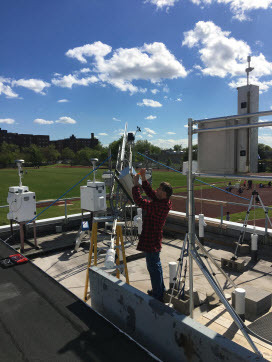Air Mail: News About NY Air Quality
The New York State Department of Environmental Conservation sent this bulletin on 11/14/2017 12:45 PM EST |
| DEC Delivers - Information to keep you connected and informed from the NYS Department of Environmental Conservation |
| Share or view as a web page || Update preferences or unsubscribe |
|
|
|
This Week’s Topics:
A Bit of Air History: Clean Air Act Amendments of 1990
In November 1990, President George H.W. Bush signed the 1990 Clean Air Act Amendments into law. The amendment was directly aimed at decreasing acid rain, urban air pollution, and toxic air emissions. It created a national permitting program, improved enforcement, phased out ozone-depleting chemicals, and addressed accidental releases of toxic air pollutants. The 1990 Amendments also allowed states to adopt California’s motor vehicle emission standards, which New York and several other states opted for, resulting in much cleaner cars. Ultimately, the Clean Air Act Amendments of 1990 were implemented to create a healthy and productive environment that also facilitated economic growth and sound environmental policies. Thanks, in part, to the Clean Air Act Amendments of 1990, New York’s air is much cleaner than it was when the Clean Air Act of 1970 was passed into law. Let’s continue to keep our air clean, NY! Photo Caption: Division of Air Resources staff Mike Christophersen performing regular maintenance on the air quality monitoring equipment located at the Queens College air monitoring site. This Year, New York Won’t be Having a Side of Smog With its Turkey
New York City residents may have celebrated the Thanksgiving of 1966 inside their homes with the usual merriment. However, outside their doors was record smog containing high levels of carbon monoxide, sulfur dioxide, and smoke. The smog was caused by weather patterns that created stagnant air over the east coast, which trapped pollutants in the New York City air. The smog lasted four days, from November 23 to 26, 1966. It was so bad, it caused leaders of state and local governments to insist that industries and residents take immediate action to decrease air pollution. During the four-day period, the smog was estimated to have caused about 200 deaths. Thankfully, on November 26,1966, a cold front dispersed the smog-laden air. Although unregulated industry was largely responsible for the 1966 Thanksgiving smog event, today vehicle traffic is a major contributor to emissions. To help prevent smog events like the one in 1966, DEC recommends fuel-efficient travel to visit relatives this Thanksgiving and encourages low energy consumption during the holiday. Article and Photo Source: “Smog Here Nears the Danger Point; Patients Warned.” New York Times, 25 November 1966, p. 1. New York Recycles (Every) Day!November 15th is New York Recycles Day. It is part of the national event - America Recycles Day - which is dedicated to educating and encouraging everyone to recycle each and every day. One benefit of recycling is cleaner air. In 2014, Americans produced 258 million tons of garbage and only about 35% of it was recycled or composted (download the full report from EPA). The diversion of that waste to recycling and composting facilities reduced greenhouse gas emissions (CO2) by over 181 million tons, which is equivalent to taking over 38 million passenger cars off the road for one year. If each of us recycles daily, we would substantially decrease the amount of air pollutants created by other forms of disposal and the amount of pollutants released when making new products. When deciding what to do with waste, remember; Reduce, Reuse and Recycle, NY! Stay Informed About Your Air QualityNew York’s traditional ozone season ended with the start of October. DEC still publishes daily ground-level ozone and particulate matter pollution forecasts year round using a scale called the Air Quality Index (AQI). DEC sends an air quality alert when there is a high AQI value, which indicates polluted air. Individuals with pre-existing respiratory and cardiovascular conditions or individuals who exercise outdoors should take caution during an air quality alert. The AQI can be accessed in 3 ways:
We would like to know what you think. Please send your Air Mail! questions or comments to us at DAR.web@dec.ny.gov.
|


 Photo Caption: View of New York City looking south from the Empire State Building on Nov. 24, 1966, historically one of New York City’s poorest air quality days. Photo Credit: Neal Boenzi, New York Times, Nov. 25, 1966.
Photo Caption: View of New York City looking south from the Empire State Building on Nov. 24, 1966, historically one of New York City’s poorest air quality days. Photo Credit: Neal Boenzi, New York Times, Nov. 25, 1966.